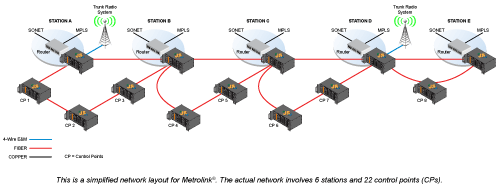News and Product Updates
Metrolink Chooses JumboSwitch
09/06/2011The Southern California Regional Rail Authority (Metrolink) commuter rail system has chosen TC Communication’s JumboSwitch® Gigabit Ethernet platform to connect the Control Points and Centralized Train Control (CTC) equipment in its "last mile" field network segments.
As a key part of the Metrolink communications network upgrade, the JumboSwitch will help provide a "communications pipe" with more capacity than the leased telephone line and radio network transport system that was previously in place. This expanded data pipe will run almost entirely over fiber and use a combination of SONET, MPLS and Ethernet for transport.
The JumboSwitch was chosen because it was projected to provide lower long term ownership costs in terms of simpler network build-outs, training, certifications and maintenance. It also met rigorous environmental requirements that called for field network Ethernet Switches to be ruggedized to +80ºC degrees in certain Control Points that were exposed to extreme summertime temperatures.
Initial JumboSwitches will transport mainly Ethernet traffic; however, several chassis were also configured with Analog/Dry Contact cards to provide a radio-over-IP connection for remote Control Points that were located too far from radio towers for quality transmission.
The primary goal for the Metrolink upgrade was to design a system with a high degree of connectivity and scalability that would create a communications architecture that would support CTC and allow the network to grow over the coming years.
The overall redesigned Metrolink communication network features six communication shelters at the stations that provide the ingress points for the field side network segments (Control Points). The communication shelters consist of a SONET node, MPLS connection (T1), Router, and a TC Communications Gigabit Ethernet JumboSwitch Platform.
Established in 1992, the Southern California Regional Rail Authority (SCRRA) commuter rail system operates seven routes and 55 stations. It operates 144 weekday commuter trains on more than 388 route miles through six counties in Southern California and averages 40,000 weekday riders.
Centralized Train Control (CTC) is a form of railway signaling where train routing decisions are controlled from a central office. A train dispatcher at the centralized office controls a system that commands the railroad interlockings and traffic flows within the CTC territory. Previously, these commands had to be carried out by train crews or local signal operators.
